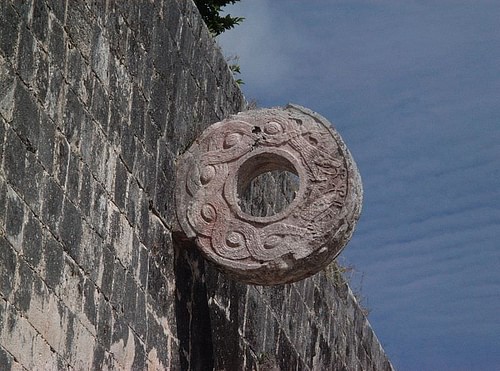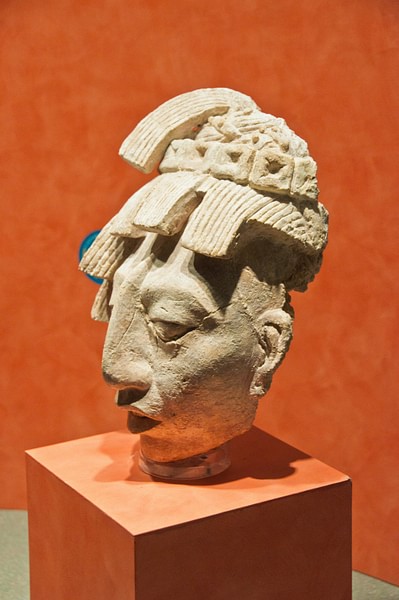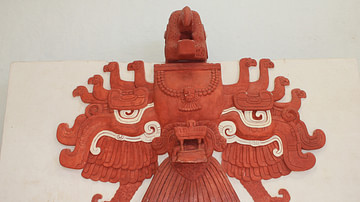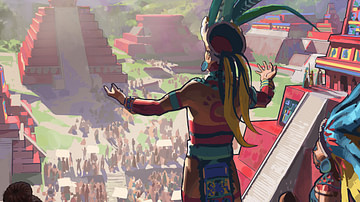The Mayan religious text, the Popol Vuh (known by many names, among them, The Light That Came From Beside The Sea) is the Quiche Maya story of creation translated into Spanish in the early 18th century CE by the missionary Francisco Ximenez from much older tales. As most of the books of the Maya were burned by the Bishop of the Yucatan, Diego de Landa, in July of 1562 CE, this text is all the more important in understanding Mayan culture and religious beliefs even though information is available elsewhere through glyphs, stele, assorted art work, and the three famous Mayan books (known as the Dresden, Paris, and Madrid Codices after the cities where they were taken) which survived Landa's auto-de-fe. The Popol Vuh has been called “the Mayan Bible” and this designation is unfortunate in that it presents the Mayan text in the interpretative light of the better known western scripture. Unlike the stories and poems which make up the anthology of ancient texts known as `The Bible', the Popol Vuh was never considered a revelatory work by the Maya who heard the tales it contains. It was interpreted by the Maya much in the same way as the ancient Greeks received and understood Homer's Iliad and Odyssey: as stories to be understood as the way things could have been, could be, not as any direct `Truth' revealed by an omnipotent god to human beings. The Maya referred to the work as an Ilb'al - an instrument of sight - which provided a hearer with clarity.
The Popol Vuh is a collection of stories which describe the creation of the world, of human beings, and how order was established by the great Hero Twins, Hunahpu and Xbalanque, through their victory over the forces of darkness and death. The characters whose tales are told in the stories are carefully constructed figures who symbolize the planets and the stars and a reader who recognizes this understands that one is encountering in these characters a vision of the world quite different from that presented in the Bible. While the tales told may be mythical in nature, the truths represented could be empirically proven by observing the paths the planets took (most notably Venus) and the positions of the stars. It was clear to the Maya, from astronomical observations, that all of life was cyclical and this eternal round of existence was made so by the cyclical nature of time.
A World of Spiritual Forces
It could be argued that time itself is the supreme god of the Maya pantheon as the intricate calendars of the Maya rose from, and then directed, the religious beliefs. The religion of the ancient Maya infused every aspect of their civilization from their architecture, to their dress and personal appearance, their sports, and, of course, their calendar. The Maya believed that the gods, though living high in the mists of Tamoanchan, were an integral part of their daily lives. The jungles which ringed their cities were inhabited by spirits and by the great god of the woods, Yum Caax, protector of plants and animals. The cities themselves each had a patron god who made the city thrive by accepting the invitation to residence in the central temple. When the rains came, it was because the god Chac was pleased and when the lightning flashed it was the work of the lord Yaluk. Each individual had a `Way', a spirit guide known as a Wayob, who helped him or her throughout life and could appear as an animal, or in dreams, to impart important messages from the spiritual realm. Each year, at the spring and autumn equinox, the great god Kukulcan descended from the sky down the staircase of his temple at Chichen Itza as was (and is still) clearly recognized by the shadow the serpent god moving down the steps to meet the stone heads at the base. The whole of the earth, and human life, then, was imbued with spiritual forces which needed to be recognized, honored, and regularly consulted in order for the community and the individual to prosper.
The Calendar & Role of the King
To the Maya, there was no difference between what a modern-age person would define as `science' and religion. Mathematics and Astronomy were a part of religious observance and went to the creation of the Sacred Calendar. The calendar was of such importance that, when the gods made the second attempt to create human beings, they decided to destroy them because the humans lacked the ability to consult the calendar and, so, to honor the gods. The Maya had a secular calendar to track the days and the seasons and a sacred calendar to predict the future and chart the courses of the stars. The scribes and the priests were astronomers and mathematicians and worked to understand the cycles of the planets in order to recognize in those patterns the celestial meaning being imparted by the gods. This meaning, then, would be carried to the ruler of the city who was considered an intermediary between the gods and the people. Blood was the food of the gods and the king and his court were not exempt from this sacrifice. Rituals surrounding royal blood-letting included drawing a string of thorns through the tongue or penis and spiking the ears or tongue with sharp spines. The blood was then let to fall on paper which was burned as an offering to the gods. If the offering was acceptable - so determined by the pattern of the burning paper - the petition of the king and his people was granted and, if not, further sacrifice would need to be made.
Human Sacrifice
While animals and precious gems were regularly surrendered to the gods in ritual, human sacrifice was central to the religious observations of the Maya (although a modern-day visitor to Mayan sites will hear the tour guides say differently). Excavations in and around the Sacred Cenote at Chichen Itza, as well as at other sites, have revealed bones of what seem to be sacrificial victims and human sacrifice is depicted in stele, in paintings, and in carvings throughout the region the ancient Maya inhabited. Some of these victims were captives taken from other villages or cities but some were citizens of the community who were honored in being chosen as messengers to the gods. Diego de Landa, wrote, “Their festivals were only to secure the goodwill of favor of their gods…They believed them angry whenever they were molested by pestilences, dissensions, or droughts or the like ills, and then they did not undertake to appease the demons by sacrificing animals, nor making offerings only of their food and drink, or their own blood and self-afflictions of vigils, fasts and continence; instead, forgetful of all natural piety and all law of reason they made sacrifices of human beings as easily as they did of birds” (Ancient Maya, 90). Sometimes this sacrifice took the form of being thrown into the Sacred Cenote and, other times, the victim was disemboweled or had the heart torn out on an altar of a temple. As the Maya believed in the cyclical nature of life, nothing ever truly `died', and so the individual sacrificed was considered to have simply `moved on' to live among the gods. Whatever form the sacrifice took did not finally matter because the individual was guaranteed instant transport to the realm of the gods and by-passed the arduous road most other souls needed to travel after death.
The Afterlife
To the Maya, the afterlife was a journey of the soul toward paradise; but there was no guarantee at all that one would reach one's destination. At death, the soul went down to the underworld, a dark and frightening place called Xibalba (or Metnal) which was populated by terrifying deities with names like Bloody Teeth, Flying Scab, and Bloody Claw. In perpetual darkness, the underworld had rivers of blood and pus and the trees were dead, the landscape barren. The Lords of Xibalba were just as apt to steer a soul in the wrong direction on its quest as the right one. Having arrived in Xibalba, one needed to not only navigate one's way across it but, then, ascend the nine levels to reach the middle world (earth) and then thirteen more levels before arriving at Tamoanchan (paradise). Once one attained the realm of the gods, one would then descend to a lower level, on the earth or just above it, to live in eternal happiness. The only souls considered exempt from this journey were sacrificial victims, women who died in childbirth, those killed in warfare, suicides, and those who died playing the ball game Pok-a-Tok.
The Sacred Ball Game: Pok-a-Tok
Pok-a-Tok was more than just a popular sport as it symbolized the struggle of the forces of life and death, light and darkness, and, it is thought, was also an act of sacrifice to the gods who enjoyed watching the game as much as the people did. Two teams of seven players each would attempt to score a rubber ball through a sideways hoop attached to a wall (sometimes as high as twenty feet in the air, sometimes lower or higher) without using their hands or feet. Players were only allowed to use their heads, shoulders, hips, elbows, knees and, sometimes, wrists. Scoring a point was so difficult that a single game could continue for days and the play was so rough that participants were frequently killed in the course of it. Prisoners of war were often sent to play in the great ball courts of the cities but not, as many think, as a punishment; they were a sacrifice to the gods. For many years, since engravings and stele concerning the game were first discovered, it was thought that the losing team (or losing captain) was sacrificed but as a clearer understanding of Maya culture has emerged it has become apparent that it was the winning team (or winning captain) who was beheaded at the game's conclusion in that the victim was then sent instantly to paradise. There was no doubt he was received well by the gods because they loved Pok-a-Tok as much as mortals did and would appreciate the gift of an excellent player. Even so, the claim that the winning team was executed is still a subject of some debate. The Mayanists Schele and Matthews contend that, "the most popular [myth surrounding the ballgame] says that the Maya sacrificed the winners so as to give a perfect gift to the gods. There is no evidence for this interpretation in any of the ancient or historical sources" (210). Those who disagree with Schele and Matthews claim that the long-standing belief that the losers were sacrificed, or that prisoners of war were forced to play to the death as a means to dishonor and punish them, is not consistent with the religious and cosmological beliefs of the Maya. The gods would have been uninterested in receiving a losing team or captain as a gift and would have visited the city with wrath instead of benevolence. Further, the concept of the prisoners of war being punished may simply be a conflation of the Maya game in the ball courts and the Roman gladiatorial games in the coliseum first suggested by 19th century interpreters of the game. A definitive answer on whether the winners or losers were sent to their deaths is not yet available because extant glyphs are often open to both interpretations. Some modern-day Maya Daykeepers (shamans) have claimed that the winners were killed but whether this is the majority opinion is not known as there has been no systematic study of this particular question with the Daykeepers of the modern Maya.

The Popol Vuh
The importance of Pok-a-Tok as a religious ritual is illustrated clearly in the Popol Vuh. In this text, the early demi-gods Hun Hunahpu and Vucub Hunahpu (symbolizing planets and fertility) are excellent Pok-a-Tok players. It is their enjoyment of the game, and the noise they make in playing it, which enrages the Lords of Xibalba who invite the brothers to the underworld on the pretext of playing against them in a game. Once the young men arrive in Xibalba, however, they are tricked and murdered. Their bodies are buried under the ball court but Hun Hunahpu's head is placed in the axis of a calabash tree as a warning to others of the Xibalban's strength. This head (which is animated by both brothers) later spits into the palm of the virgin goddess Xquiq and she becomes pregnant with the two boys known as the Hero Twins, Hunahpu an Xbalanque, also both expert Pok-a-Tok players, who defeat the Lords of Xibalba and the forces of chaos and darkness. In playing the game, then, the Maya were re-creating the victory of the twins over death while, simultaneously, honoring the gods in the present with sacrifice. The Mayanist Dennis Tedlock writes, “For Mayans, the presence of a divine dimension in narratives of human affairs is not an imperfection but a necessity and it is balanced by a necessary human dimension in narratives of divine affairs” (Popol Vuh, 59). The divine dimension in the game of Pok-a-Tok was multi-layered and, like everything else in Mayan life, reflected the importance of the gods in one's daily life.
The Cyclical Nature of Existence
The religious beliefs of the Maya, then, were intricately bound up in cycles, whether the cycle of a day, a ritual performed, or the great ball game. All of existence carried on eternally in the great cycle of time and this was illustrated through the calendar, both the secular and the sacred versions. The calendars were envisioned as great cogs with interlocking teeth which clicked precisely and, if understood properly, enabled one to predict future events. Much has been made recently of the Maya allegedly predicting the end of the world on 21 December 2012 but, again, this is a result of interpreting the beliefs of the Maya through a western European understanding. As time was an eternal god, bound up in, outside of, and manifesting itself through the workings of the universe, it could never end. The world brought into being through the operation of time as represented by the gods could never end either as that would contradict the very nature of existence as understood by the Maya. 21 December 2012 is better understood as simply the end of one cycle (known as a Baktun) and the beginning of another as, to the Maya, there is never an end to anything, only ceaseless change through the eternal work of time.








